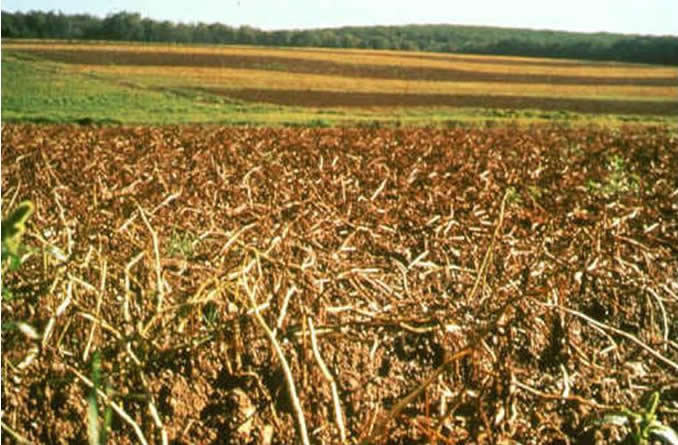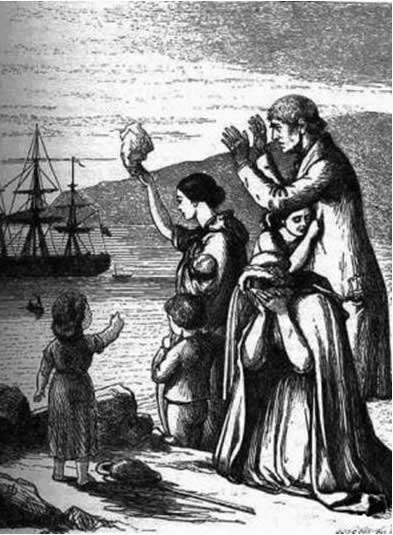| P. s. pv. tomato DC3000 | P. s. pv.phaseolicola 1448A | |||
|
Module
4: Social Science Issue How a plant disease changed history |
||||
|
Additional Resources: Student
Resources |
Glossary
of Terms (for CAPITALIZED words) |
The Potato Late Blight Disease
In Module 1 - Lab and Module 4 - Lab you observed how Pseudomonas syringae can cause bacterial speck disease on tomato plants. Here you will learn about a different plant disease, that, like the Bubonic Plague discussed in Module 1 - Social Science-changed the course of human history The pathogen Phytophthera infestans
What is done today to fight Phytophthera infestans
Plant diseases can have impacts far beyond the farm. In the past, several plant diseases have caused famines that literally changed history. The disease called ‘Potato Late Blight’ is one of the most famous examples. This disease devastated Ireland’s potato crop in the mid 19th century and caused death by starvation of many Irish people and migration of millions of others to the United States.
The Pathogen Phytophthera infestans
The Potato Late Blight is caused by Phytophthora infestans. This PLANT PATHOGEN was long thought to be a fungus because itphysically resembles microscopic filamentous fungi. Scientists today know that P. infestans is not a fungus. They call it an oomycete (one major difference is that, unlike fungi, P. infestans cell walls contain cellulose instead of chitin).
The pathogen can infect the leaves of a potato plant, the stem or the underground potato itself (which is referred to as a tuber). The pathogen produces microscopic sporangia that are carried by wind, animals or water. Once a sporangium reaches a plant, P. infestans begins to grow and rapidly infects plant tissues. Rain or fog greatly enhancesthe spreading of the pathogen because water helps the dissemination of sporangia and because moisture is needed for the development of a sporangium once it has reached the plant.
 |
Phytophthora means ‘plant destroyer’ and this pathogen certainly earns its name. Under the right conditions (wet weather with moderate temperatures), the pathogen can rapidly devastate a whole field. The disease spreads rapidly because P. infestans grows fast and reproduces very quickly and efficiently (it produces a large number of sporangia that can spread to healthy plants next to the infected ones, or even far away). |
Field of potatoes completely destroyed by late blight
|
P. infestans can also survive over winter in potato tubers, even after they have been harvested. If left on the field or planted the next year, those infected tubers can be responsible for a new epidemic.
To learn more about Phytophthora infestans and Late Blight Disease, and to see pictures of the pathogen and disease symptoms on plants, consult the laboratory website of Professor William Fry at Cornell University.
In 1845, Late Blight struck potato fields in Ireland for the first time. The pathogen had probably entered the country on potato tubers that had been taken onboard ships traveling from America. The weather in Ireland was unfortunately perfect for Phytophthora infestans growth and spreading. Disease occurred everywhere. The pathogen survived over the winter and the following year, almost all of Ireland’s potato crop was destroyed.
 |
At this time, potato was the major staple food in Ireland and families often relied on it completely to live. When the Late Blight occurred, the Irish people suffered from severe famine. |
An 1849 depiction of Bridget O'Donnell and her two children during the famine.
Credit: Illustrated London News, December 22, 1849
Source:Wikipedia
|
|
| People were dying from starvation or because diseases such as cholera that spread through the population because of the famine. Survivors had almost no choice but to emigrate, when they were not forced to do so by the landlords of their small lands. The journey to a new country was a very hard one. Emigrants were usually crowded in ships without enough food for the whole crossing. Many died before reaching their new country. |  |
'Emigrants Leave Ireland'
Credit: Henry Doyle for 'Illustrated History of Ireland' by Frances Mary Cusack, 1868
Source:Wikipedia
|
|
People left Ireland with the hope of a better life elsewhere. The majority went to the United States (especially Boston, New York and Baltimore) although Great Britain, Canada, and Australia were also destinations. For America it was the beginning a new chapter in its history as this was the first big wave of immigration into the country.
The exact figures of the demographic consequences of the famine are hard to determine. It is estimated than starting in 1845, in a period of time of ten years, Ireland lost almost 25% of its population. Almost 1 million died from starvation or disease and about 2 million emigrated to other countries. The Irish people have had a major positive impact on the new countries they called their homes.
To learn more about the Irish Potato Famine you can:
Search the ‘entire collection’ of the Digital History and consult this website.
What is done today to fight Phytophthora infestans
Several agricultural practices are used to prevent another Late Blight epidemic. Potato and tomato farmers (P. infestans also attacks tomato plants) are encouraged to know how to recognize the first symptoms of Late Blight in order to be able to treat the infected plants with pesticides before the spreading of the pathogen to the entire field. They are also encouraged to check the weather to do preventive treatments if conditions become too favorable for the pathogen. Any infected tuber or fruit must also be destroyed to avoid an epidemic the following season.
Some wild potato varieties are naturally resistant to P. infestans. Studies are underway to determine genes in these plants that confer the resistance (several resistance genes have already been identified) and to introduce them into cultivated potato varieties by plant breeding techniques or genetic engineering.
The threat of Late Blight disease still exists and climate change could make things worse by allowing P. infestans infections to happen in places that were spared so far. In Peru, warmer temperatures recently occurring in the mountains are making the weather more favorable to the pathogen. Peru is the homeland of potatoes, and a major outbreak of late blight there could have a tremendous economic and social impact.
To learn more about the management strategies for late blight disease consult the Late blight fact sheet of the Cornell University’s Plant disease diagnostic Clinic.
To learn more about the studies on Resistance to Late Blight, consult the paragraph ‘Resistance to Late Blight’ on this page of the NSF potato genome project’s website.
To learn more about the Late Blight in Peru, watch this Audio Slideshow on NPR website.
